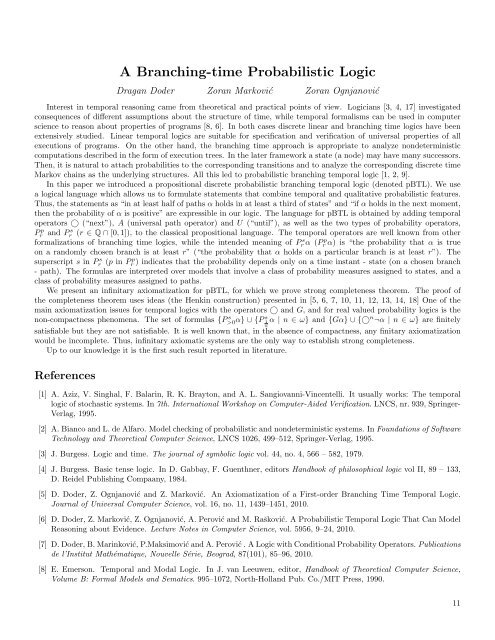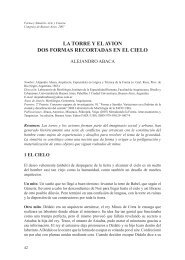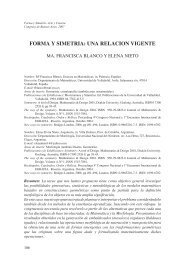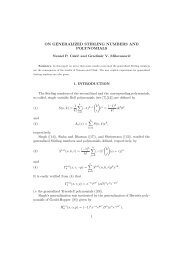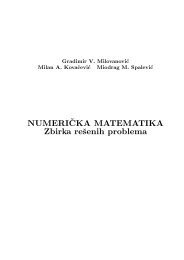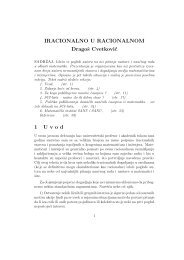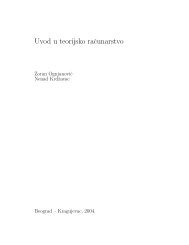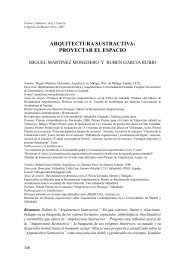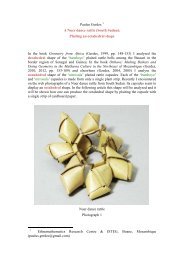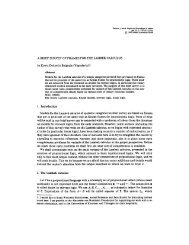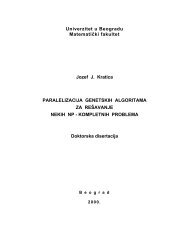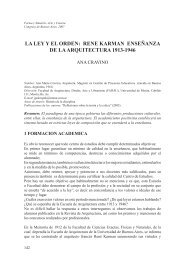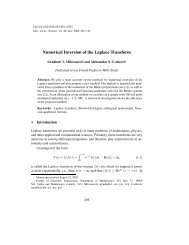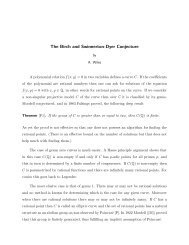Knjiga apstrakata - Mathematical Institute of the Serbian Academy of ...
Knjiga apstrakata - Mathematical Institute of the Serbian Academy of ...
Knjiga apstrakata - Mathematical Institute of the Serbian Academy of ...
You also want an ePaper? Increase the reach of your titles
YUMPU automatically turns print PDFs into web optimized ePapers that Google loves.
A Branching-time Probabilistic LogicDragan Doder Zoran Marković Zoran OgnjanovićInterest in temporal reasoning came from <strong>the</strong>oretical and practical points <strong>of</strong> view. Logicians [3, 4, 17] investigatedconsequences <strong>of</strong> different assumptions about <strong>the</strong> structure <strong>of</strong> time, while temporal formalisms can be used in computerscience to reason about properties <strong>of</strong> programs [8, 6]. In both cases discrete linear and branching time logics have beenextensively studied. Linear temporal logics are suitable for specification and verification <strong>of</strong> universal properties <strong>of</strong> allexecutions <strong>of</strong> programs. On <strong>the</strong> o<strong>the</strong>r hand, <strong>the</strong> branching time approach is appropriate to analyze nondeterministiccomputations described in <strong>the</strong> form <strong>of</strong> execution trees. In <strong>the</strong> later framework a state (a node) may have many successors.Then, it is natural to attach probabilities to <strong>the</strong> corresponding transitions and to analyze <strong>the</strong> corresponding discrete timeMarkov chains as <strong>the</strong> underlying structures. All this led to probabilistic branching temporal logic [1, 2, 9].In this paper we introduced a propositional discrete probabilistic branching temporal logic (denoted pBTL). We usea logical language which allows us to formulate statements that combine temporal and qualitative probabilistic features.Thus, <strong>the</strong> statements as “in at least half <strong>of</strong> paths α holds in at least a third <strong>of</strong> states” and “if α holds in <strong>the</strong> next moment,<strong>the</strong>n <strong>the</strong> probability <strong>of</strong> α is positive” are expressible in our logic. The language for pBTL is obtained by adding temporaloperators ○ (“next”), A (universal path operator) and U (“until”), as well as <strong>the</strong> two types <strong>of</strong> probability operators,Pr p and Pr s (r ∈ Q ∩ [0, 1]), to <strong>the</strong> classical propositional language. The temporal operators are well known from o<strong>the</strong>rformalizations <strong>of</strong> branching time logics, while <strong>the</strong> intended meaning <strong>of</strong> Pr s α (Pr p α) is “<strong>the</strong> probability that α is trueon a randomly chosen branch is at least r” (“<strong>the</strong> probability that α holds on a particular branch is at least r”). Thesuperscript s in Prs (p in Pr p ) indicates that <strong>the</strong> probability depends only on a time instant - state (on a chosen branch- path). The formulas are interpreted over models that involve a class <strong>of</strong> probability measures assigned to states, and aclass <strong>of</strong> probability measures assigned to paths.We present an infinitary axiomatization for pBTL, for which we prove strong completeness <strong>the</strong>orem. The pro<strong>of</strong> <strong>of</strong><strong>the</strong> completeness <strong>the</strong>orem uses ideas (<strong>the</strong> Henkin construction) presented in [5, 6, 7, 10, 11, 12, 13, 14, 18] One <strong>of</strong> <strong>the</strong>main axiomatization issues for temporal logics with <strong>the</strong> operators ○ and G, and for real valued probability logics is <strong>the</strong>non-compactness phenomena. The set <strong>of</strong> formulas {P>0α} s ∪ {P s 1 α | n ∈ ω} and {Gα} ∪ {○ n ¬α | n ∈ ω} are finitelynsatisfiable but <strong>the</strong>y are not satisfiable. It is well known that, in <strong>the</strong> absence <strong>of</strong> compactness, any finitary axiomatizationwould be incomplete. Thus, infinitary axiomatic systems are <strong>the</strong> only way to establish strong completeness.Up to our knowledge it is <strong>the</strong> first such result reported in literature.References[1] A. Aziz, V. Singhal, F. Balarin, R. K. Brayton, and A. L. Sangiovanni-Vincentelli. It usually works: The temporallogic <strong>of</strong> stochastic systems. In 7th. International Workshop on Computer-Aided Verification. LNCS, nr. 939, Springer-Verlag, 1995.[2] A. Bianco and L. de Alfaro. Model checking <strong>of</strong> probabilistic and nondeterministic systems. In Foundations <strong>of</strong> S<strong>of</strong>twareTechnology and Theoretical Computer Science, LNCS 1026, 499–512, Springer-Verlag, 1995.[3] J. Burgess. Logic and time. The journal <strong>of</strong> symbolic logic vol. 44, no. 4, 566 – 582, 1979.[4] J. Burgess. Basic tense logic. In D. Gabbay, F. Guenthner, editors Handbook <strong>of</strong> philosophical logic vol II, 89 – 133,D. Reidel Publishing Compaany, 1984.[5] D. Doder, Z. Ognjanović and Z. Marković. An Axiomatization <strong>of</strong> a First-order Branching Time Temporal Logic.Journal <strong>of</strong> Universal Computer Science, vol. 16, no. 11, 1439–1451, 2010.[6] D. Doder, Z. Marković, Z. Ognjanović, A. Perović and M. Rašković. A Probabilistic Temporal Logic That Can ModelReasoning about Evidence. Lecture Notes in Computer Science, vol. 5956, 9–24, 2010.[7] D. Doder, B. Marinković, P.Maksimović and A. Perović . A Logic with Conditional Probability Operators. Publicationsde l’Institut Mathématique, Nouvelle Série, Beograd, 87(101), 85–96, 2010.[8] E. Emerson. Temporal and Modal Logic. In J. van Leeuwen, editor, Handbook <strong>of</strong> Theoretical Computer Science,Volume B: Formal Models and Sematics. 995–1072, North-Holland Pub. Co./MIT Press, 1990.11


